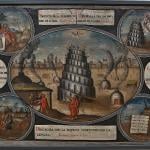In which we continue our look at creeds in The Catholic Weekly:
As we saw last time, St. Paul records a brief summary of the Faith in 1 Timothy 3:16. As a young Evangelical, that gave me pause. It meant that creeds–summaries of the Faith–were biblical, not some medieval accretion.
For, of course, even in the time of the apostles, there were already all kinds of urban legends about Jesus. Diversity of opinion about Christ and his gospel is not anything new. Jesus himself, two thousand years ago, asked the people closest to him the most important question that has ever been asked in the history of the world and they made clear that already, in his own lifetime, the Pew Research Polls on Views of Jesus were returning wildly varying answers:
Now when Jesus came into the district of Caesarea Philippi, he asked his disciples, “Who do men say that the Son of man is?” And they said, “Some say John the Baptist, others say Elijah, and others Jeremiah or one of the prophets.” (Mt 16:13–14)
This is, indeed, precisely why Jesus had called his disciples: in order to create a circle of apostles (that is, “sent ones”) who could preserve the accurate story about him and make sure it got handed down without getting muddled. The chief of these Sent Ones was Simon and he was the first of the apostles to answer Jesus’ question correctly.
Much more here.











